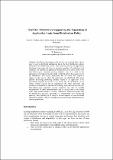Files in this item
RAFDA : Middleware supporting the separation of application logic from distribution policy
Item metadata
| dc.contributor.author | Dearle, Alan | |
| dc.contributor.author | Walker, Scott | |
| dc.contributor.author | Norcross, Stuart | |
| dc.contributor.author | Kirby, Graham | |
| dc.contributor.author | McCarthy, Andrew | |
| dc.date.accessioned | 2011-03-30T15:31:32Z | |
| dc.date.available | 2011-03-30T15:31:32Z | |
| dc.date.issued | 2005 | |
| dc.identifier | 5009079 | |
| dc.identifier | d9fed3e8-0081-4612-bdb9-00ca4d532b0e | |
| dc.identifier.citation | Dearle , A , Walker , S , Norcross , S , Kirby , G & McCarthy , A 2005 , RAFDA : Middleware supporting the separation of application logic from distribution policy . Technical Report , no. CS/05/3 , University of St Andrews . | en |
| dc.identifier.other | ArXiv: http://arxiv.org/abs/1006.3742v1 | |
| dc.identifier.other | ORCID: /0000-0002-4422-0190/work/28429109 | |
| dc.identifier.uri | https://hdl.handle.net/10023/1737 | |
| dc.description | Submitted to Middleware 2005 | en |
| dc.description.abstract | Middleware technologies often limit the way in which object classes may be used in distributed applications due to the fixed distribution policies imposed by the Middleware system. These policies permeate the applications developed using them and force an unnatural encoding of application level semantics. For example, the application programmer has no direct control over inter-address-space parameter passing semantics since it is fixed by the application's distribution topology which is dictated early in the design cycle by the Middleware. This creates applications that are brittle with respect to changes in the way in which the applications are distributed. This paper explores technology permitting arbitrary objects in an application to be dynamically exposed for remote access. Using this, the application can be written without concern for its distribution with object placement and distribution boundaries decided late in the design cycle and even dynamically. Inter-address-space parameter passing semantics may also be decided independently of object implementation and at varying times in the design cycle, again, possibly as late as run-time. Furthermore, transmission policy may be defined on a per-class, per-method or per-parameter basis maximizing plasticity. This flexibility is of utility in the development of new distributed applications and the creation of management and monitoring infrastructures for existing applications. | |
| dc.format.extent | 20 | |
| dc.format.extent | 565734 | |
| dc.language.iso | eng | |
| dc.publisher | University of St Andrews | |
| dc.relation.ispartofseries | Technical Report | en |
| dc.subject | cs.DC | en |
| dc.subject | Distributed, parallel, and cluster computing | en |
| dc.subject | QA75 Electronic computers. Computer science | en |
| dc.subject.lcc | QA75 | en |
| dc.title | RAFDA : Middleware supporting the separation of application logic from distribution policy | en |
| dc.type | Report | en |
| dc.contributor.institution | University of St Andrews. School of Computer Science | en |
| dc.identifier.url | http://arxiv.org/abs/1006.3742 | en |
This item appears in the following Collection(s)
Items in the St Andrews Research Repository are protected by copyright, with all rights reserved, unless otherwise indicated.

